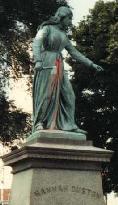| Hannah Duston Escapes Indian Kidnapping |
Haverhill, Massachusetts (April 1697) - Hannah Emerson Duston1 and two other captives survived a horrific kidnapping at the hands of marauding Indians, and in early April 1697, returned home to Haverhill, Massachusetts, with Indian scalps in hand as proof of the terror she and her fellow captives endured.
On March 15, 1697 -- just one week after Hannah Duston gave birth to her 12th child -- a small band of Indians raided the settlement at Haverhill, Massachusetts, while Hannah's husband Thomas Duston worked in the fields. Thomas was able to rescue his other seven children, but the raiding Indians captured Hannah, the newborn infant and Hannah's nurse, Mary Neff, among others. The captives were all gathered and forced to march quickly away into the woods.
Due to the baby, Mary Neff had trouble keeping up, so one of the Indians took the baby from her, and before Hannah's horrified eyes, "dashed out its brains against an apple tree," as the story goes. The Indians then continued the forced march as fast as the captives could be pushed.
Hannah Duston had not been out of bed since the birth and had only one shoe on for this march. During the next few days, the captives were pushed through about 100 miles of wilderness over rough trails -- often through leftover snow, knee-deep mud and across icy brooks. Rocks tore up Hannah's feet, and as they weren't dressed warmly, they suffered badly from the cold. Finally, they made it to a camp on an island in the river near the current location for Concord, New Hampshire. This camp was shared by two Indian men with three squaws and seven children. They also had a captive English boy named Samuel Lennardson. Samuel had already been held captive for 18 months. Once at this island, the Indians decided to rest for a few days before going on the Canada to sell the women to the French as slaves. Samuel, who was 14, was considered part of the Indian family, but was in fact homesick and tired of being with the Indians. At this point, the Indians figured the women were both too tired and scared to be any threat, but instead Hannah and Mary plotted with Samuel to escape. At night after the Indians were all asleep, Hannah, Mary and Samuel collected some hatchets from around the camp, then attacked and killed 10 of the 12 sleeping Indians. Only one of the Indian women and a small Indian boy escaped into the night woods. This all occurred on the night of March 30, 1697.
Shortly after Hannah, Mary and the boy Samuel left in the Indian canoes, they realized their story would not be readily believed upon their return. So they returned to the camp and took scalps of the victims to prove what they had done. They then paddled down river at night until they reached Haverhill several days later.
At the time, the English colonies were not offering bounties for scalps taken from Indians, but an exception was made in this case and a substantial bounty was awarded to Hannah, Mary and Samuel. Hannah received 25 pounds, and Mary and Samuel received 12 pounds and 10 shillings each.
Hannah was subsequently considered a colonial hero for decades, in fact into the 20th century. In the late 1800s, monuments with statues of Hannah were erected in the towns of Haverhill, Massachusetts, and Boscawen, New Hampshire, (near Concord) and still stand there today.
As horrible and bloody as the whole episode was, it was typical and a fairly common occurrence during the struggles between the colonies and the Indians, who were being pushed from their homelands. The brutalities at the hands of both sides were really quite atrocious. From our current perspective, the behavior of the Indians can certainly be understood; they were fighting viciously at times to save their homes. In many cases, though, the colonists actually perceived the Indians to be less than human beings -- lowly savages deserving of their fate. Just as the colonists methodically wiped out all predatory
 Paint-Splattered Hannah Duston Statue in Haverhill, Massachusetts (1984) |
Hannah Emerson Duston was long considered a colonial heroine. Her story took place toward the end of the King William's War. This war was the American version of the War of the League of Augsburg, in which Spain, Sweden, the Palatinate and Bavaria in Germany, England and Holland all fought against the French during the reign of William and Mary the 2nd, 1689-1702, in England. As part of the American war, the Governor of Canada for the French, the Count de Frontenac, contracted American Indians to raid the English frontier settlements.
In the early 1980s, Hannah's statue in Haverhill, Massachusetts, was splattered with red paint! The local librarian stated that some local Indians splashed the paint onto the statue -- the red paint being symbolic of the blood their ancestors shed at the hands of the settlers -- to protest the glorification of the slaughter of their ancestors.
Interesting, but sometimes savage stuff...this history of mankind.
|
Footnote:
1Hannah Emerson Duston is the 8th great-grandmother of Norma Jean Newhouse. |
| Other Stories... |
|
Narrative of Carmen Cassani's Youth in Italy (April 1982) |
|
Newhouse Cousin Great Contributor to Aviation Advances (1998) |
|
Kobel Massacre (November 1755) |
|
Ancestors Among Early Settlers in Palatine Migration to Tulpehocken, PA (1732) |
|
Machias Rebels Capture British schooner at Start of Revolutionary War (June 1775) |
|
Jeremiah Gatchell Migrates to Pennsylvania (Abt 1704) |
|
Joseph Gatchell Punished for Heresy (July 1684) |
|
The Great Corwin Burglary (March 6, 1683/1684) |